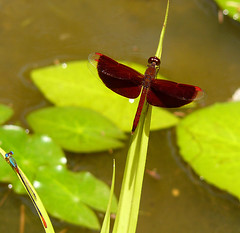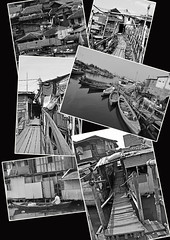

This blog is about sharing our experience of living in Singapore from February 2007 thru to February 2012 and all the wonderful things we saw, what we did and the places we have been. In other words, our everyday experiences! This blog will continue to survive as I add more information when appropriate.
Sunday, 31 October 2010
The Kranji War Memorial

Saturday, 30 October 2010
we walk by on a pathway or is it a sidewalk?
Some areas of the northern part of Jakarta are actually below sea level and therefore subject to frequent flooding.... even at high tide, most homes have water lapping at the front door!
Monday, 25 October 2010
every man's home is his castle!
Click HERE for the blog posting on the Pasar Ikan
Click HERE for the blog posting on the fishermen boats
Click HERE for the posting on the Syahbandar Tower
Click HERE for the blog on the ride on the Bajaj
Sunday, 24 October 2010
the fishermen and their prahu
The fishermen that live in the kampong of Luar Batang, near the old port area in Jakarta, leave their homes in the early hours of the morning and sometimes of an evening for fishing in the Java Sea. Returning by 4.30am for the Pasar Ikan (fish market) to sell the catch from 5.00am each day.
Saturday, 23 October 2010
Two Bugs ......

Two Bugs ......
Originally uploaded by Leone Fabre.
at the Singapore Botanical Gardens.
he is a RED DRAGON FLY and the one on the left is a DAMSEL FLY!!
Was so busy trying to capture the red one each time he landed that I didn't see the damsel fly on the lower left till I uploaded to my computer!!
Friday, 22 October 2010
more haze in Singapore!
High: 32 °C
Wind Calm.
20% chance of precipitation
Heat Index: 39 °C
and the PSI at 7.00am was 88
it's all due to the illegal forest clearing fires in Indonesia's Sumatra Island that is sending haze across to Malaysia and Singapore. ... this happens every year as farmers on the islands of Borneo and Sumatra clear land by burning trees and bushes to make way to plant crops and raise cattle.
I am not going into the personal issues of why and why not here
as it is far too political and this is a very public blog!
the following are a couple of images
taken from our balcony at 2.30pm yesterday:
and this is the same view we usually experience:
and it is even clear at night:
scroll back and recheck the first images
am sure you can see there is a very big difference!
some of the articles and comments in the newspapers are:
Haze from forest fires in Sumatra has forced schools to close in Singapore and Malaysia, and prompted warnings from governments of both countries.
Haze from Indonesia brought Singapore's air pollution to it's worst level in four years yesterday!!
.... and the smoke is expected to remain in the air till at least Saturday, though the situation could worsen as fires continue to burn in parts of Sumatra being cleared by farmers and the prevailing winds blow more smoke this way. :-(
The Pollutant Standards Index (PSI) hovered at 80 early this morning!
and as a friend wrote:
PSI - Please Stop Inhaling!
PSI 80 - Please stop inhaling 80% of the time!
Officials say they will press the
Indonesian government to take action.
Tuesday, 19 October 2010
collage of Luar Batang, Jakarta

collage of Luar Batang, Jakarta
Originally uploaded by Leone Fabre.
Last week I visited this old Kampong in Jakarta..... Walking along the uneven paths around the Kampong, it is easy to forget that you are actually in the city of Jakarta.
There are many children running around and playing near the old port area ..... these families are very poor.
There are about 5000 people living here at Luar Batang, which is the old village beside Pasar Ikan (Fish Market)
I have no idea where Pasar Ikan ends and Luar Batang begins. It is difficult to describe life here ...... and then when there is a high tide, the water comes lapping around their feet and into their homes.
This is just a collage of a few images I took while there
my visit to the pasar ikan in Jakarta
The following three images is of when you first enter the market area in the early afternoon. For those that wish to witness the auctions and the selling of the 'fresh fish' it is better to go here in the early hours of the morning.... even as early as 5.00am
Sunda Kelapa is the old port of Jakarta located on the estuarine of Ciliwung River. "Sunda Kalapa" is the original name, and it was the main port of Sunda Kingdom of Pajajaran. The port is situated in North Jakarta, Indonesia. Today the old port only accommodate pinisi, a traditional two masted wooden sailing ship serving inter-island freight service in the archipelago. Although it is now only a minor port, Jakarta had its origins in Sunda Kelapa and it played a significant role in the city's development. This is where the Portuguese traded with the Hindu Kingdom of Pajajaran in the early 16th century.
The Pasar Ikan (Fish Market) sells various kinds of fish - including the dried fish as seen above - and also has a very strong commercial network.
Here, one gets to observe the working climate of Jakarta's modest, hardworking and outspoken fishermen. Although it markets primarily fresh fish, you can also find shops here selling anything from household goods to seashells and boat fittings. Many late-night revelers also come here to savor some grilled fish served up by the food stalls.
the above images are rather misleading as it looks like an 'normal market' where there is plenty of room to wander around. Not so, we are in a very dark and damp area with walkways only for one person to walk along. The walkways usually have water sloshing around, and whatever floats along with it ..... there were many photos I did not take as it was totally inappropriate to do so. .....
..... and for the first time - ever - I started to gag on what I was seeing and smelling. I have been deep into the old markets of Siem Reap, Saigon and Mauritius and I have never come across anything remotely like what I saw here.
But I had asked Bram - the guide - to take me here, to see it first hand for myself, and am glad I did get to see this market. Part of me wishes I had gone earlier when there were more people, but had also heard it was very unsafe for females to just 'wander around' at that time.
The fish catch of the day is auctioned in the early morning (usually before 5.00am) at the old fish market warehouse as seen in the two following images ...... it was only when when I enlarged these images on screen, that I saw the huge spiders and their webs hanging from the rooftop!
once out in the open we continued to explore the rest of the Pasar Ikan and as it was early afternoon most of the fish sellers had gone home and all that were left were the household goods being sold as seen below....
The following image is typical of the area we were walking through .... this was a pathway in front of a food stall, so one needs to be extremely careful of where one is walking.
The more adventurous might like to cruise across the Old Harbor, between Pasar Ikan and Sunda Kelapa, on a raft. Negotiate first with the abang (raftsman) for a good rate. We did not do this as the taxi boats looked 'very fragile' and I was not so keen on falling in to the Ciliwung River either!

































































